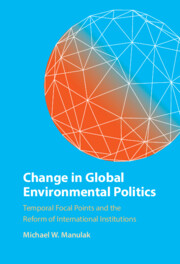 Change in Global Environmental Politics
Change in Global Environmental Politics Book contents
- Change in Global Environmental Politics
- Change in Global Environmental Politics
- Copyright page
- Dedication
- Contents
- Figures and Tables
- Acknowledgments
- Abbreviations
- 1 Introduction
- 2 It’s About Time
- 3 The Stockholm Conference and Institutional Change
- 4 UNEP and the 1982 Nairobi Conference
- 5 The Brundtland Commission and the Seeds of Change
- 6 The Rio Conference and Institutional Change
- 7 Post-UNCED UN Environmental Institutions
- 8 Conclusion
- Bibliography
- Index
7 - Post-UNCED UN Environmental Institutions
Published online by Cambridge University Press: 12 May 2022
- Change in Global Environmental Politics
- Change in Global Environmental Politics
- Copyright page
- Dedication
- Contents
- Figures and Tables
- Acknowledgments
- Abbreviations
- 1 Introduction
- 2 It’s About Time
- 3 The Stockholm Conference and Institutional Change
- 4 UNEP and the 1982 Nairobi Conference
- 5 The Brundtland Commission and the Seeds of Change
- 6 The Rio Conference and Institutional Change
- 7 Post-UNCED UN Environmental Institutions
- 8 Conclusion
- Bibliography
- Index
Summary
This chapter analyzes United Nations environmental politics from 1993 to 2021, focusing heavily on the 2002 World Summit on Sustainable Development (WSSD), or the “Johannesburg summit,” and the 2012 “Rio+20” United Nations Conference on Sustainable Development (UNCSD). The chapter examines the institutional ambiguities created by the 1992 Rio “Earth Summit” and international efforts to address them. It analyzes in detail failed institutional bargaining surrounding WSSD and carries the empirical investigation forward to the Rio+20 summit. The second Rio Earth Summit constituted a Temporal Focal Point in the history of United Nations environment governance and precipitated large-scale institutional change. Among the significant institutional changes emerging from the conference were the transformation of the United Nations Environment Programme (UNEP), the creation of a High-Level Political Forum on Sustainable Development (HLPF), and the approval of a process for articulating the UN’s Sustainable Development Goals (SDGs) and the 2030 Agenda. The chapter also provides a brief discussion of more recent UN environmental cooperation, focusing on UNEP, the HLPF, and the SDGs, including progress in combatting climate change and the loss of biodiversity.
Keywords
- Type
- Chapter
- Information
- Change in Global Environmental PoliticsTemporal Focal Points and the Reform of International Institutions, pp. 207 - 232Publisher: Cambridge University PressPrint publication year: 2022


